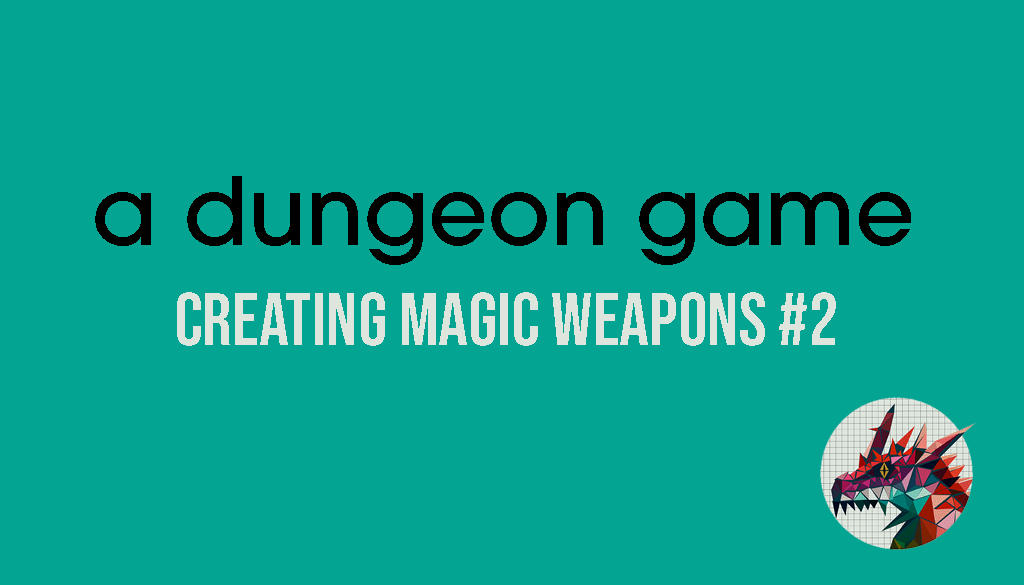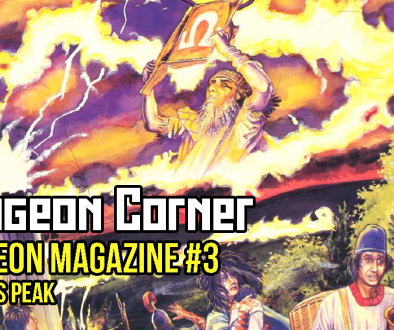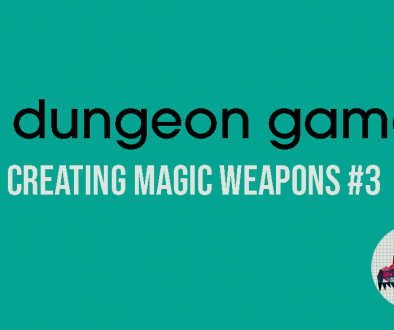A Dungeon Game’s Magic Weapons Pt. 2
This post first appeared on Patreon. To get access to all posts at least a week before they go live on Loot The Room, plus more exclusive content, sign up here.
Last time I talked about my aims for magic weapons in a dungeon game. To quickly recap:
- All (or most) magic weapons should be intelligent.
- All magic weapons should have at least one unique ability that “breaks” the game rules in some way.
- The GM should have tools to easily create new magic weapons for their game.
It’s no secret that I’ve drawn on 2nd Edition AD&D a lot in writing a dungeon game. This has largely been in the way I balance the game – my experience thresholds and treasure quantities all use the numbers in 2nd Edition as their base, and some my monster stats are at least partially derived from it. None of it is an exact copy, but why reinvent the wheel?
With that in mind, I thought it was worth looking at AD&D’s magic sword generators for inspiration. Both the first and second editions of AD&D have fairly extensive tables for generating intelligent weapons. For the rest of this post I’ll be referring to the original version of the 2nd edition Dungeon Master Guide, not the Revised edition, so if you want to follow along your page numbers may not match, but generally this stuff is found in the appendices (I believe it’s Appendix 3 in the Revised edition, as in the edition I’m using).
This procedure starts on page 186 with table 113: Weapon Intelligence and Capabilities, which lets us determine the weapon’s intelligence, method of communication, and its capabilities. It looks like this:
| D100 Roll | Intelligence | Communication | Capabilities |
|---|---|---|---|
| 01-34 | 12 | Semi-empathy | 1 primary ability |
| 35-59 | 13 | Empathy | 2 primary abilities |
| 60-79 | 14 | Speech | 2 primary abilities |
| 80-91 | 15 | Speech | 3 primary abilities |
| 92-97 | 16 | Speech | 3 primary abilities± |
| 98-00 | 17 | Speech and Telepathy±±± | 3 primary abilities±± plus 1 extraordinary power |
- ± The weapon can also read languages/maps of any nonmagical type.
- ±± The weapon can read languages as well as magical writings.
- ±±± The weapon can use either communication mode at will, with language use as any speaking weapon.
Before I go any further in this process I can already see that this can be fairly easily adapted to a dungeon game. I will need to adjust the percentages to account for the fact that the game only uses d6 and d20, but otherwise I can more or less copy this.
When I’m writing for a dungeon game I often run into tension between my desire for the game to be fast and “rules light”, and my love of crunchy trad games with lots of cool bits to play around with. This is something that pops up most often when it comes to monsters. When I write for Pathfinder 2 I love making monsters and coming up with cool things that they can do, and I find a lot of satisfaction in putting together a complex stat block that has a set of abilities that work well together and make the monster feel unique. With a dungeon game I’m always tempted to go too far with monsters when really I want the majority of them to do just one cool thing, and I’m feeling that same urge when it comes to these weapons. For that reason – and because I’m still struggling to see how I’m going to “tool-ify” this process – I don’t know if I want quite so many results that grant 3 primary abilities here.
Here’s what my first run at this table looks like for a dungeon game.
| Cunning (2d6) | Capabilities | Communication |
|---|---|---|
| 2-5. | 1 primary ability | Empathy |
| 4-6. | 1 primary ability | Wielder Telepathy |
| 7-9. | 2 primary abilities | Wielder Telepathy |
| 10-11. | 2 primary abilities | Speech |
| 12. | 3 primary abilities | Speech & Telepathy |
Rather than rolling percentile dice, we simply generate the weapon’s Cunning and derive the rest of its attributes from that. Player Character Cunning is in the 3-18 range, and this only gives us magic weapon intelligence up to 12, which sort of works but also sort of doesn’t. Highly intelligent weapons are fun and introduce a new dynamic into play, and I’m robbing myself of that here. Let’s expand this out to 3d6 and see how it looks.
(You’ll notice I’ve also played around with the communication methods here. That’s just adjusting things to my own personal tastes, and there’s no real reasoning behind these choices other than that it felt right.)
| Cunning (3d6) | Capabilities | Communication |
|---|---|---|
| 3-5 | 1 minor ability | Semi-empathy |
| 6-8 | 1 minor ability | Empathy |
| 9-10 | 1 major ability | Empathy |
| 11-13 | 1 major ability | Wielder Telepathy |
| 14-15 | 1 major abilities and 1 minor ability | Wielder Telepathy |
| 16 | 2 major abilities | Speech |
| 17 | 3 major abilities + read lanaguages and maps | Speech |
| 18 | 3 major abilities + read languages and magical writings | Speech & Telepathy |
On this second run at it I’ve introduced the concept of Major and Minor abilities. I still don’t know exactly how I’m going to generate these, but I feel like we get a good variety of weapons from this table.
Going back to AD&D, the next set of tables generate:
- Weapon alignment
- Weapon primary abilities
- Weapon extraordinary powers
- Special purpose & special purpose power
- Languages spoken by the weapon
- Weapon ego
Weapon ego (and from that, its derived personality score) makes for some interesting outcomes but it’s also a bit of a pain to work out and keep track of, and I’m not sure it achieves much that isn’t achieved by the weapon having a Cunning score that’s used as the basis for saves. That said, the constant shifting of player character personality scores (which you have to work out once a character begins wielding an intelligent weapon) makes for some interesting outcomes as the weapon’s intelligence takes advantage of moments of weakness. I’ll have to think about whether this is something I want to codify into the rules of a dungeon game or whether this is something that can be dealt with simply through GM advice.
What I’m really interested in here are the powers that AD&D grants to magic weapons. Here’s table 115: Weapon Primary Abilities
| d100 | Ability |
|---|---|
| 01-11 | Detect “elevator”/shifting rooms/walls in a 10′ radius |
| 12-22 | Detect sloping passages in a 10′ radius |
| 23-33 | Detect traps of large size in a 10′ radius |
| 34-44 | Detect evil/good in a 10′ radius |
| 45-55 | Detect precious metals, kind, and amount in a 20′ radius |
| 56-66 | Detect gems, kind, and number in a 5′ radius |
| 67-77 | Detect magic in a 10′ radius |
| 78-82 | Detect secret doors in a 5′ radius |
| 83-87 | Detect invisible objects in a 10′ radius |
| 88-92 | Locate object in a 120′ radius |
| 93-98 | Roll twice on this table ignoring scores of 93 to 00 |
| 99-00 | Roll on Table 116 instead |
And Table 116: Weapon Extraordinary Powers:
| d100 | Power |
|---|---|
| 01-07 | Charm person on contact – 3 times/day |
| 08-15 | Clairaudience, 30 yards range – 3 times/day, 1 round per use |
| 16-22 | Clairvoyance, 30 yards range – 3 times/day, 1 round per use |
| 23-28 | Determine direction and depth – 2 times/day |
| 29-34 | ESP, 30 yards range – 3 times/day, 1 round per use |
| 35-41 | Flying, 120’/turn – 1 hour/day |
| 42-47 | Heal – 1 time/day |
| 48-54 | Illusion, 120 yards range – 2 times/day, as the wand |
| 55-61 | Levitation, 1 turn duration = 3 times/day, at 6th level of magic use ability |
| 62-67 | Strength – 1 time/day (upon widler only) |
| 68-75 | Telekinesis, 250 pounds maximum – 2 times/day, 1 round each use |
| 76-81 | Telepathy, 60 yards range – 2 times/day |
| 82-88 | Teleportation – 1 time/day, 600 pounds maximum, casting time 2 |
| 89-94 | X-ray vision, 40 yards range – 2 times/day |
| 95-97 | Roll twice on this table ignoring scores of 95-97 |
| 98-99 | Character may choose 1 power from this table |
| 00 | Character may choose 1 power from this table, and then roll for a Special Purpose on Table 117 |
The immediate thing that I notice about this abilities is that they’re really boring. If I wanted to replicate this I could simply say that every magic weapon knows X amount of Rituals and have GMs roll for them. That’s not a terrible idea for a minor ability, but I want my weapons to be actually interesting.
For now I don’t have an answer, and so I’m just going to think about it a little more. I like the base table, though, and I think it’s a good starting point. All that remains to be done is to figure out how to draw the rest of the owl.




